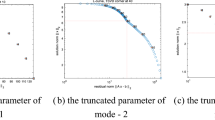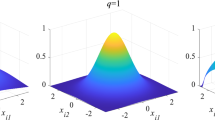Abstract
High-dimensional and unlabeled data collected from multi-sensor is a common scenario in practical production. The fault diagnosis and health stage (HS) division of bearing under different degradation processes is easily limited due to unlabeled and high-dimensional data. This work designs an intelligent fault diagnosis and HS division strategy for unlabeled and high-dimensional data. An adaptive tensor density peaks search (ATDPS) clustering algorithm is proposed for the HS division of rolling bearing. Moreover, to enhance the clustering performance, a novel neighborhood least square (NLS) technique is developed for feature space denoising, whose effectiveness and superiority are verified compared with the other feature space denoising techniques. The proposed strategies are subsequently applied to three benchmark cases and compared with other clustering methods. The experiment results demonstrate that the proposed strategy can reliably and accurately divide the different degradation stages depending on less prior knowledge. Furthermore, the presented HS division approach successfully monitors degradation with compound failure, showing potential for practical application.
Graphical abstract




















Similar content being viewed by others
Data availibility statement
The data in Case 1 is from our laboratory facility and is not publicly available unless requested and approved by us.
Abbreviations
- HS:
-
Health Stage
- RUL:
-
Remaining Useful Life
- NLS:
-
Neighborhood Least Square
- DPS:
-
Density Peaks Search
- ADPS:
-
Adaptive Density Peaks Search
- ATDPS:
-
Adaptive Tensor Density Peaks Search
- PAM:
-
Partition Around Medoids
- SVD:
-
Singular Value Decomposition
- VMD:
-
Variational Mode Decomposition
- DDS:
-
Drivetrain Dynamics Simulator
- TF:
-
Statistics Feature in Time Domain
- FF:
-
Statistics Feature in Frequency Domain
- IF:
-
Inner Race Fault
- OF:
-
Outer Race Fault
- BF:
-
Ball Fault
- N:
-
Normal
- N.D.:
-
Naturally Degraded
References
Liu Q, Wang YX, Xu YG (2021) Synchrosqueezing extracting transform and its application in bearing fault diagnosis under non-stationary conditions. Measurement 173:108569
Gao DW, Zhu YS, Kang W et al (2022) Weak fault detection with a two-stage key frequency focusing model. ISA Trans 125:384–399
Chen R, Tang L, Hu X et al (2021) Fault diagnosis method of low-speed rolling bearing based on acoustic emission signal and subspace embedded feature distribution alignment. IEEE Trans Ind Inform 17(8):5402–5410
Li X, Shao HD, Lu S et al (2022) Highly efficient fault diagnosis of rotating machinery under time-varying speeds using LSISMM and small infrared thermal images. IEEE Trans Syst Man Cybern-Syst Early Access 1–15
Li M, Yan C, Liu W et al (2022) Fault diagnosis model of rolling bearing based on parameter adaptive AVMD algorithm. Appl Intell 53(3):3150–3165
He DQ, Liu CY, Jin ZZ et al (2022) Fault diagnosis of flywheel bearing based on parameter optimization variational mode decomposition energy entropy and deep learning. Energy 239:122108
Jin ZZ, He DQ, Ma R et al (2022) Fault diagnosis of train rotating parts based on multi-objective VMD optimization and ensemble learning. Digit Signal Prog 121:103312
Chen G (2022) Timed failure propagation graph construction with supremal language guided Tree-LSTM and its application to interpretable fault diagnosis. Appl Intell 52:12990–13005
Xing S, Lei YG, Yang B et al (2022) Adaptive knowledge transfer by continual weighted updating of filter kernels for few-shot fault diagnosis of machines. IEEE Trans Ind Electron 69(2):1968–1976
Shao HD, Xia M, Wan J et al (2022) Modified stacked autoencoder using adaptive morlet wavelet for intelligent fault diagnosis of rotating machinery. IEEE-ASME Trans Mechatron 27(1):24–33
Lei YG, Li NP, Guo L et al (2018) Machinery health prognostics: A systematic review from data acquisition to RUL prediction. Mech Syst Signal Proc 104:799–834
Ding N, Li H, Yin Z et al (2020) Journal bearing seizure degradation assessment and remaining useful life prediction based on long short-term memory neural network. Measurement 166:108182
Ma X, Hu Y, Wang M et al (2021) Degradation state partition and compound fault diagnosis of rolling bearing based on personalized multilabel learning. IEEE Trans Instrum Meas 70:3520711
Suh S, Lukowicz P, Lee YO (2022) Generalized multiscale feature extraction for remaining useful life prediction of bearings with generative adversarial networks. Knowledge-Based Syst 237:107866
Jiang KS, Li ZX, Zhou YY et al (2022) Transient waveform matching based on ascending multi-wavelets for diagnostics and prognostics of bearing deterioration. ISA Trans 120:330–341
Liu S, Fan L (2022) An adaptive prediction approach for rolling bearing remaining useful life based on multistage model with three-source variability. Reliab Eng Syst Saf 218:108182
Sun M, Wang H, Liu P et al (2022) Stack autoencoder transfer learning algorithm for bearing fault diagnosis based on class separation and domain fusion. IEEE Trans Ind Electron 69(3):3047–3058
Berahmand K, Mohammadi M, Faroughi A et al (2022) A novel method of spectral clustering in attributed networks by constructing parameter-free affinity matrix. Cluster Comput 25(2):869–888
Berahmand K, Nasiri E, Mohammadiani RP et al (2021) Spectral clustering on protein-protein interaction networks via constructing affinity matrix using attributed graph embedding. Comput Biol Med 138:104933
Ding P, Wang H, Dai Y et al (2019) MDCCS based multistage life prediction of slewing bearing with a novel performance description: an improved variational mode decomposition approach. Exp Tech 43:341–358
Fan Y, Ma T, Xiao F (2021) An improved approach to generate generalized basic probability assignment based on fuzzy sets in the open world and its application in multi-source information fusion. Appl Intell 51:3718–3735
Wang W, Li Y, Song Y (2021) Fault diagnosis method of hydraulic system based on multi-source information fusion and fractal dimension. J Braz Soc Mech Sci Eng 43:561
Qin AS, Mao HL, Hu Q et al (2021) Bearing fault diagnosis method based on ensemble composite multi-scale dispersion entropy and density peaks clustering. IEEE Access 9:24373–24389
Jia XM, Qian N, Huang DQ et al (2022) A clustered blueprint separable convolutional neural network with high precision for high-speed train bogie fault diagnosis. Neurocomputing 500:422–433
Henry FN, Ying WT, Ghulam M et al (2019) Data fusion and multiple classifier systems for human activity detection and health monitoring: Review and open research directions. Inf Fusion 46:147–170
Mehrdad R, Kamal B, Elahe N et al (2021) Review of swarm intelligence-based feature selection methods. Eng Appl Artif Intell 100:104210
Wei ZX, He DQ, Jin ZZ et al (2023) Density-based affinity propagation tensor clustering for intelligent fault diagnosis of train bogie bearing. IEEE Trans Intell Transp Syst, Early Access
Hu C, Wang Y (2019) Multidimensional denoising of rotating machine based on tensor factorization. Mech Syst Signal Proc 122:273–289
Feng Z, Yu X, Zhang D et al (2020) Generalized adaptive mode decomposition for nonstationary signal analysis of rotating machinery: Principle and applications. Mech Syst Signal Proc 136:106530
Yao RH, Jiang HK, Wu ZG et al (2021) Periodicity-enhanced sparse representation for rolling bearing incipient fault detection. ISA Trans 118:219–237
Hu YX, Zhang B, Zhang Y et al (2022) A feature-level full-reference image denoising quality assessment method based on joint sparse representation. Appl Intell 52(10):11115–11130
Li W, Zhang S, Rakheja S (2016) Feature denoising and nearest-farthest distance preserving projection for machine fault diagnosis. IEEE Trans Ind Inform 12(1):393–404
Wang Y, Wei Z, Yang J (2019) Feature trend extraction and adaptive density peaks search for intelligent fault diagnosis of machines. IEEE Trans Ind Inform 15(1):105–115
Rodriguez A, LaioP A (2014) Clustering by fast search and find of density peaks. Science 344(6191):1492–1496
Yu W, Zhao C (2019) Online fault diagnosis in industrial processes using multimodel exponential discriminant analysis algorithm. IEEE Trans Control Syst Technol 27(3):1317–1325
Li M, Wang Y, Wei C (2021) Intelligent fault diagnosis of machines based on adaptive transfer density peaks search clustering Shock Vib 9936080
Han Y, Li K, Ge F et al (2022) Online fault diagnosis for sucker rod pumping well by optimized density peak clustering. ISA Trans 120:222–234
Liu Y, Liu Y, Chan K (2010) Tensor distance based multilinear locality-preserved maximum information embedding. IEEE Trans Neur Networks 21(11):1848–1854
Wang B, Lei Y, Li N et al (2020) A hybrid prognostics approach for estimating remaining useful life of rolling element bearings. IEEE Trans Reliab 69(1):401–412
Ma J, Zhou S (2022) Discriminative least squares regression for multiclass classification based on within-class scatter minimization. Appl Intell 52(1):622–635
Kobak D, Berens P (2019) The art of using t-SNE for single-cell transcriptomics. Nat Commun 10:5416
Rezaei M, Fränti P (2023) K-sets and k-swaps algorithms for clustering sets. Pattern Recognit 139:109454
Acknowledgements
This work was supported by the National Natural Science Foundation of China [Grant No. U22A2053], the Major Project of Science and Technology of Guangxi Province of China [Grant No. AA20302010], the Interdisciplinary Scientific Research Foundation of Guangxi University [Grant No. 2022JCA003] and the Innovation Project of Guangxi Graduate Education [Grant No. YCBZ2023039].
Author information
Authors and Affiliations
Corresponding author
Ethics declarations
Declaration of interest statement
No conflict of interest exists in the submission of the manuscript entitled Intelligent fault diagnosis and health stage division of bearing based on tensor clustering and feature space denoising, and manuscript is approved by all authors for publication.
Additional information
Publisher's Note
Springer Nature remains neutral with regard to jurisdictional claims in published maps and institutional affiliations.
Rights and permissions
Springer Nature or its licensor (e.g. a society or other partner) holds exclusive rights to this article under a publishing agreement with the author(s) or other rightsholder(s); author self-archiving of the accepted manuscript version of this article is solely governed by the terms of such publishing agreement and applicable law.
About this article
Cite this article
Wei, Z., He, D., Jin, Z. et al. Intelligent fault diagnosis and health stage division of bearing based on tensor clustering and feature space denoising. Appl Intell 53, 24671–24688 (2023). https://doi.org/10.1007/s10489-023-04843-7
Accepted:
Published:
Issue Date:
DOI: https://doi.org/10.1007/s10489-023-04843-7




